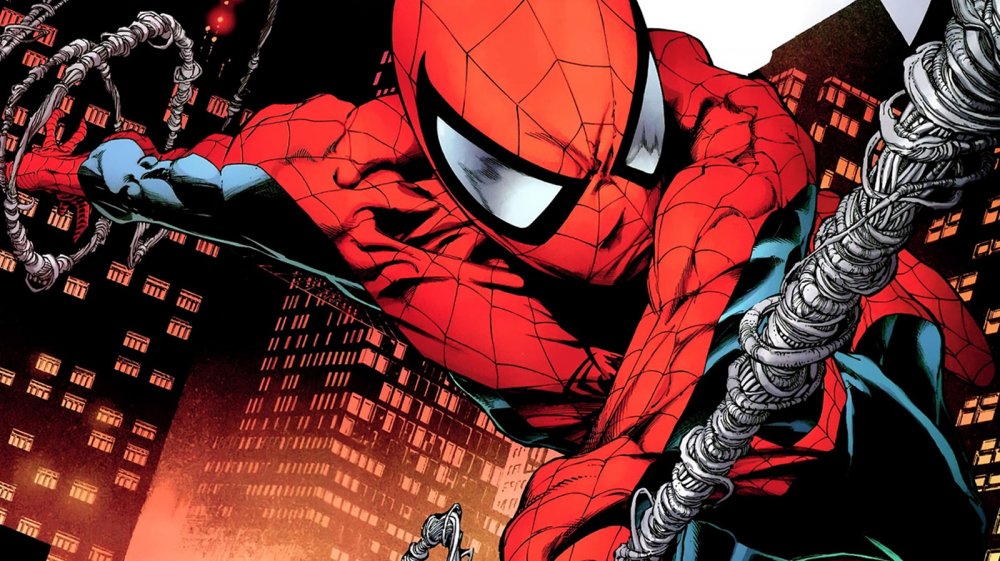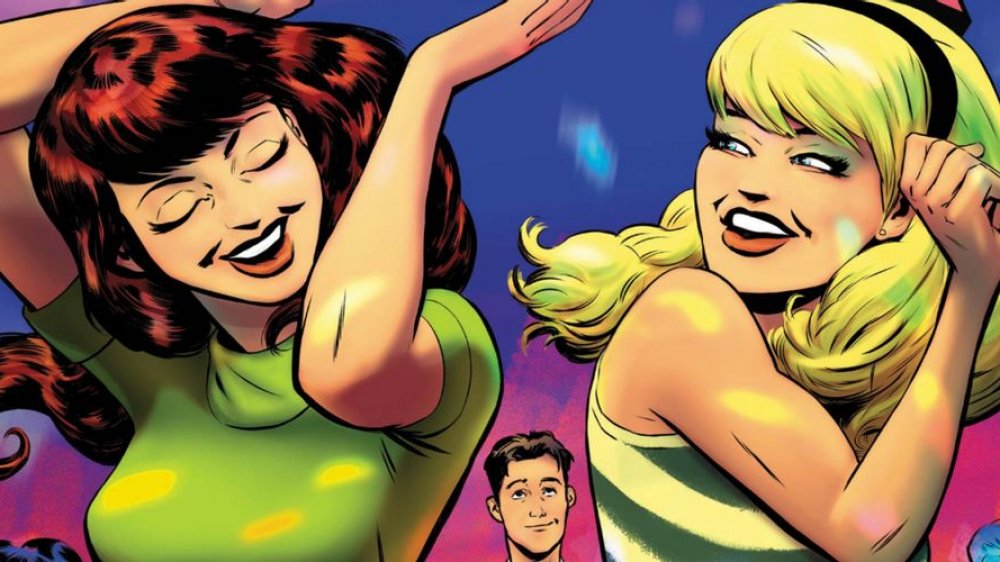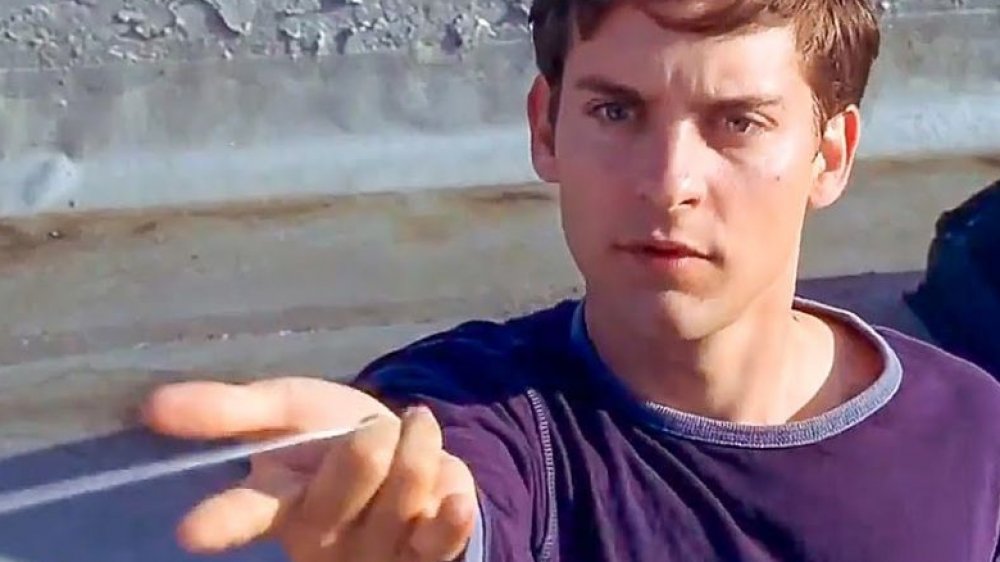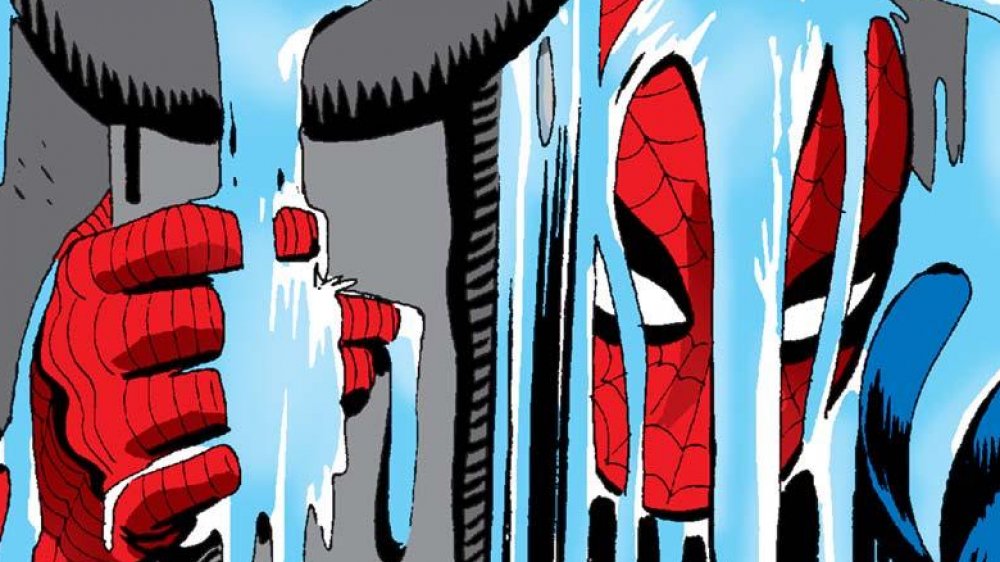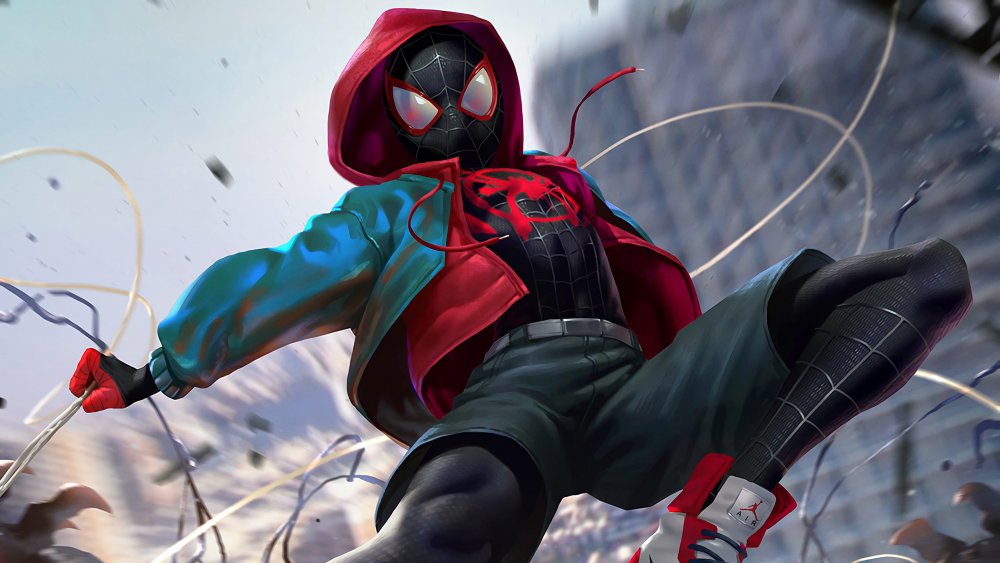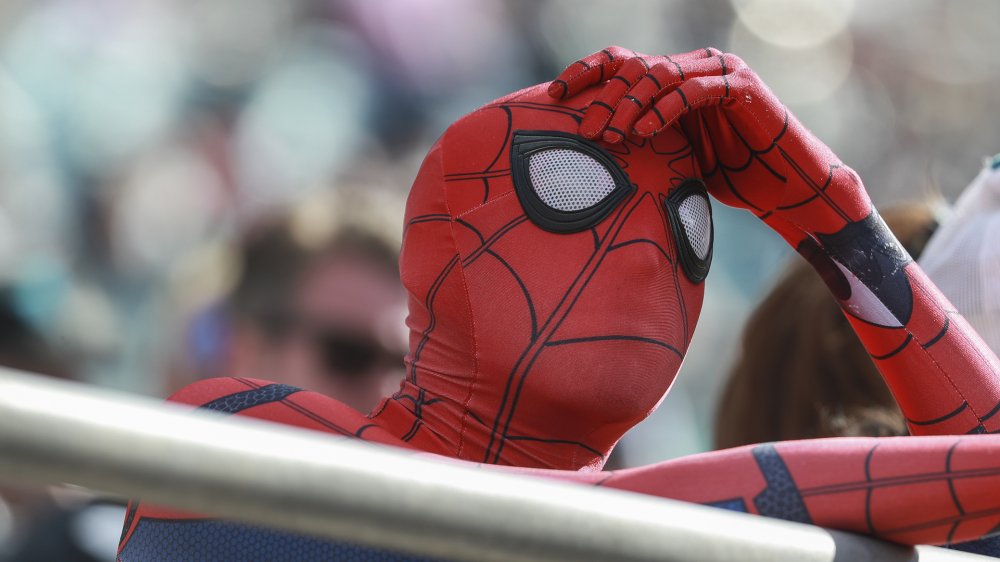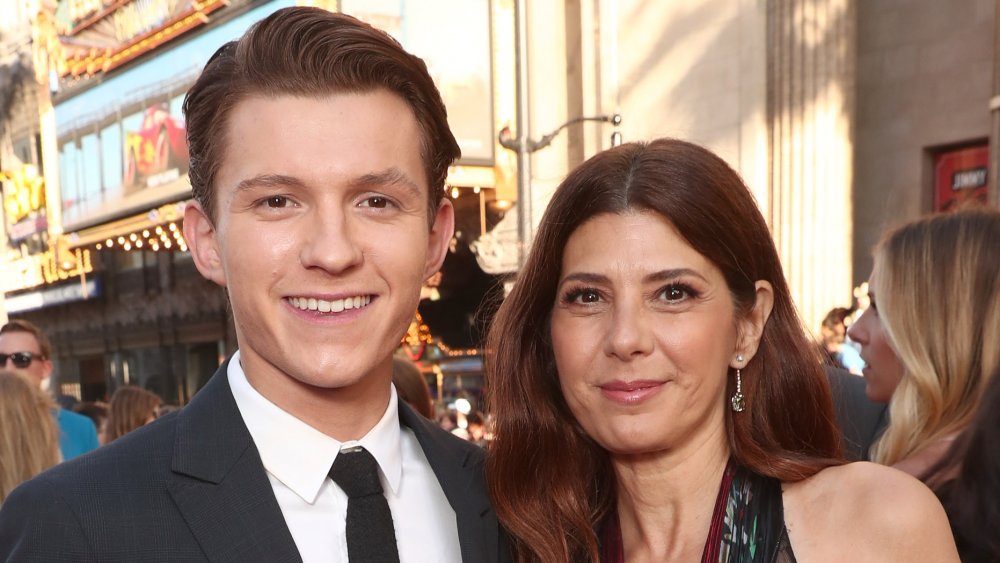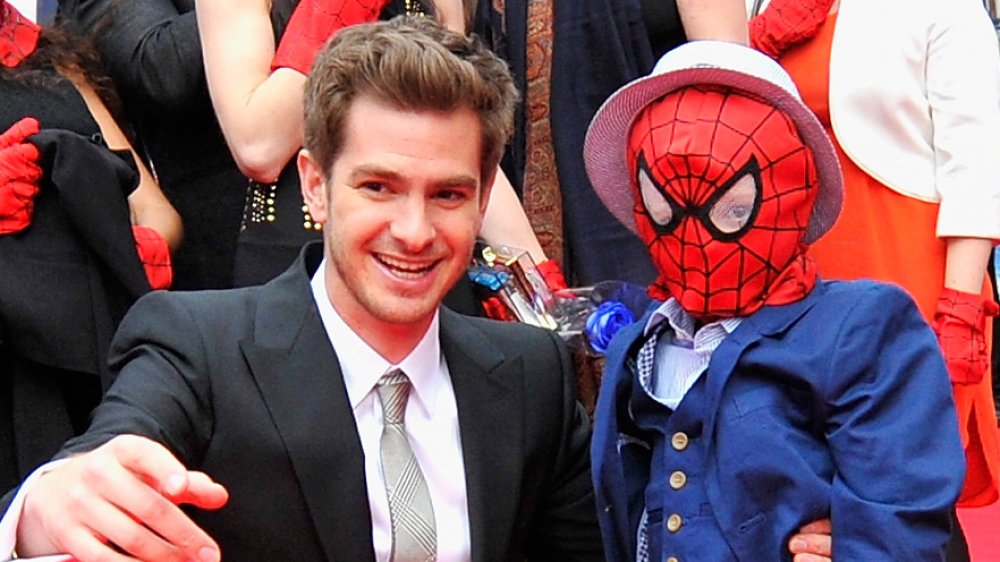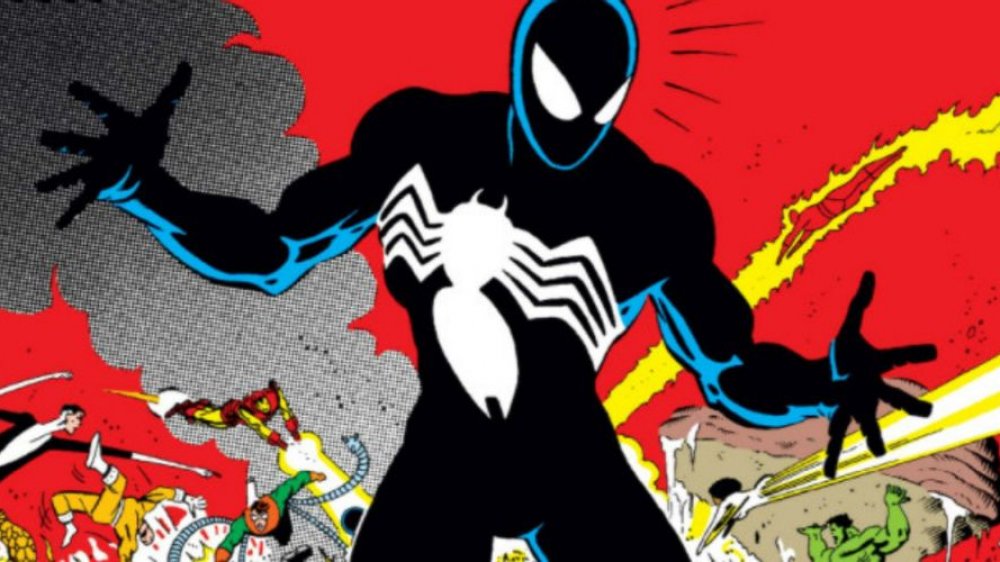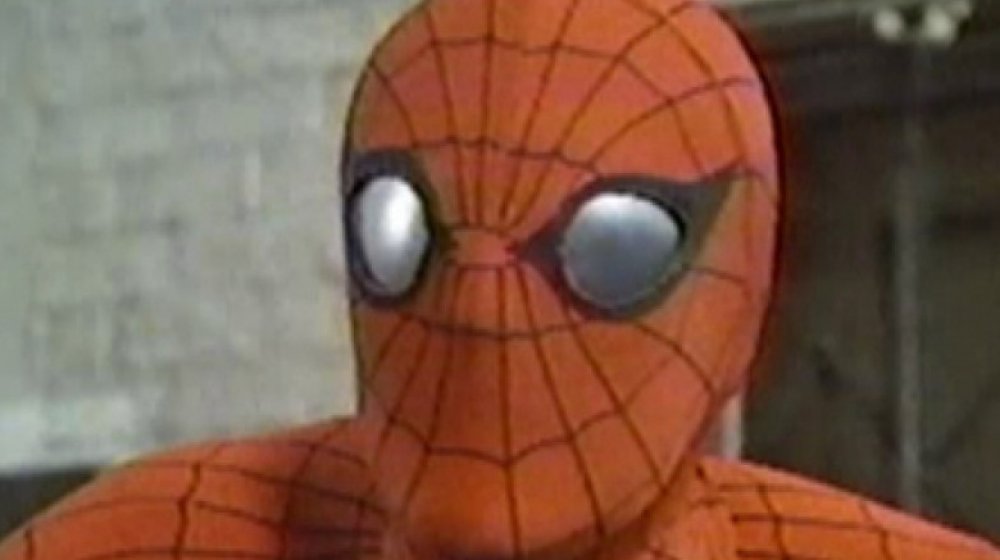Unpopular Opinions About Spider-Man That Raise Good Points
Practically since his first appearance in the August 1962 issue of Amazing Fantasy, Spider-Man has been one of the most popular superheroes in the world, spinning off TV shows, movies, toys and games, and amassing legions of fans around the world. Why? He's just cool. Ask any 8-year-old — they'll set you straight. Swinging from webs is cooler than flying. It just is. Cooler still, Spider-Man is really Peter Parker, a formerly regular kid who handles being a superhero about as well as we all would, for better or worse. He's clever and funny and powerful but he also makes mistakes and wishes he was better. Spidey might beat the bad guys by having the proportionate strength of a spider, but he captures fans with his super relatability.
But just as surely as great power comes with great responsibility, popularity comes with backlash. The most embittered criticism seems to come from Spidey's most passionate fans, who defend the character even as they pick apart each successive incarnation. Dismiss it as armchair quarterbacking at best or trolling at worst, but some of these unpopular opinions about your friendly neighborhood Spider-Man raise some good points.
Gwen Stacy is better than Mary Jane Watson
Up until Emma Stone stepped into the role of Gwen Stacy in 2012's The Amazing Spider-Man, you could separate the old school Spidey fans from the newbs by asking the name of Peter Parker's first love. Mary Jane Watson is the name that comes to most minds. After all, MJ has been Peter's feisty foil for practically every version of Spider-Man, from the newspaper comic strip adventures to the jazz-scored late '60s cartoon and Kirsten Dunst's turn in Sam Raimi's 2002 Spider-Man, which sealed the character in a new generation's memories with an upside-down kiss.
Stan Lee's OGs, however, will point out that the death of Gwen Stacy is every bit as tragic as Uncle Ben's, and does just as much to shape Spidey's character. Raimi's attempt to introduce Gwen in 2007's Spider-Man 3 failed to deliver on the character's promise, and by the time Gwen's story could finally be done justice in the 2012 reboot, it was lost in a mire of half-formed plots. Zendaya has since put her own spin on MJ's fabulousness and established her as Peter's first love interest in the most recent Spider-Man movies, so we may never see Gwen Stacy's story in the Marvel Cinematic Universe. But who knows? Perhaps Doctor Strange will run into Spider-Gwen out there in the Multiverse of Madness.
Organic webshooters make more sense
Easily the most controversial change that Sam Raimi made to the character in his 2002 telling of Spider-Man's origin story was his depiction of Spidey's web shooters as physical mutations caused by that transformative radioactive spider bite, along with his super-strength, wall-crawling, and heightened senses. Gone were the impossibly tiny web shooters from the comics. Gone were the clunky silver bracelets of 1978's Spider-Man: The Deadly Dust. This deviation from canon made no sense to purists, who preferred Peter Parker's backstory as a high school student/professional-quality photojournalist/genius inventor who creates the most durable, flexible adhesive in history, as well as the miniature device for weaponizing it... and also gains superpowers in a wholly unrelated accident.
Um... okay... That coincidence is so hard to swallow that the whole proposed series of The Amazing Spider-Man films centered on a (never fully explored) conspiracy meant to reconcile Peter's maybe-not-accidental superpowers. Over in the MCU, Peter's scientific genius is touched upon enough to remind us that he is a nerdy lil' cutie, but the creation of his highest tech is handed off to surrogate dad Tony Stark. Allowing the one spider bite to explain all of Peter's powers is the more elegant solution.
One of Stan Lee and Steve Ditko's best... is not that great
A 2001 poll of Marvel Comics readers placed this Spider-Man story at #15 on the list of "100 Greatest Marvels of All Time," and there are plenty of reasons why it's memorable. But none of those reasons are the great story.
In a nutshell, Spidey needs to get his webs on a rare isotope that will save Aunt May's life, but Doc Ock steals it and drops heavy machinery on Spidey to squish him (because he does "whatever a spider can," and that includes getting squished.) Fighting through self-doubt, garnering strength by recalling his loved ones, Spidey frees himself and saves the day. That's the whole shebang. Comic book historians tout Steve Ditko's artwork and layout for its masterful manipulation of tension. The story also plays out over three successive issues — from The Amazing Spider-Man #31 – #33 — which was a first for the title, and used dramatic flashbacks to recap some of the most emotional moments of Spidey's life. All of this gives memorable dramatic weight to "If this be my destiny"... but none of it changes the fact that the story is as basic as they come.
Miles Morales is no Mary Sue
In 2018, Into the Spider-Verse introduced movie audiences to Miles Morales, the biracial teen who takes on the mantle of Spider-Man in an alternate universe following Peter Parker's death. The movie was embraced by audiences and critics alike, and won an Oscar for Best Animated Feature. His introduction in the comics in 2011, however, was not greeted so warmly. Many saw the character as tokenism, a pandering attempt to win over an audience with a show of political correctness. Others declared Morales a "Gary Stu," the male equivalent of a "Mary Sue" — a character who is depicted as improbably powerful within their own narrative — because his powers include all of Peter Parker's plus camouflage and a finishing move called the"venom strike." Over time, however, fans have come to judge Miles Morales as Spider-Man by the excellent quality of his writing and artwork, and not by the color of his ink.
No matter what he says, Topher Grace was a better Venom than Tom Hardy
Spider-Man 3 has to be one of the least loved movies in recent decades. Even folks who claim to love it will only say things like, "They did a good job with Sandman," or "Evil Peter danced for less than a minute of actual screen time and my therapist says he can't hurt me anymore." A huge disappointment for many fans was the treatment of Eddie Brock and his alter ego Venom, both played by Topher Grace, better known as the not-at-all Eddie Brock-like Eric Forman on That '70s Show.
Grace himself admitted in an interview that he preferred Tom Hardy's performance of the character in 2018's Venom to his own, saying, "That's the character that I grew up with." While it is absolutely true that Hardy bears a closer physical resemblance to the muscle-bound Brock of the comics, there is a more malicious — one might say venomous — evil to Grace's version, even despite being given so little time in a movie crowded with characters. It is equally true that Hardy is given too much time. Forced to carry the entire film as an anti-hero, Hardy is forced to steer away from playing Brock as the toxic, manipulative jerk that he is in the comics.
Swinging from clouds is fine. It's fine!
In 2002, developers Treyarch and publishers Activision released Spider-Man for the PlayStation 2, and Spidey-lovin' gamers rejoiced. For the first time, state-of-the-art graphics and physics engines would deliver the experience of swinging through Manhattan's canyons of steel and glass just like their friendly neighborhood hero.
Well... maybe not just like him. Initial reviews expressed dismay that Spider-Man appeared to travel by swinging from ropes of webbing that were attached to clouds in the sky, or sometimes to nothing at all. The thrills of gymnastically bounding from skyscraper to skyscraper were reduced to holding down a trigger. In fact, the physics were not much of an improvement over Activision's attempt at Spider-Man in 2000. Gamers lit up message boards with wisecracks about the mysteries of cloud-swinging, and every Spider-Man game since has attempted to add a layer of realism to the action. This seems like a foolish goal, however. Games are meant to be fun, after all. You know what's not fun? Your no-Spidey Sense-having self trying to calculate the geometry of swings in real time. No one needs a game to remind them that they'd be a lousy Spider-Man.
Spider-Man is a loner... a rebel...
While Marvel Comics and the MCU pride themselves on stories with long continuities that cross over multiple titles, Spider-Man simply works better on his own, outside the larger continuity of the Marvel Universe. In fact, he's one of the few Marvel characters to have spent most of his existence appearing in multiple unrelated titles. He is a character defined by tragedy and his fear of endangering those he cares about, so partnering him with other heroes feels odd, in the same way that it feels weird to see brooding, vengeful Bruce Wayne hanging out with 'super friends."
Perhaps the old Marvel Team-Up titles featuring Spider-Man fighting alongside an unlikely partner were so much fun because any partnership with Spider-Man would be unlikely. Certainly, Spidey's wrong-headed attempt to join the Fantastic Four is played for laughs (Peter quits the team when he finds out it's a non-profit) and most of his appearances with the Avengers, both in the comics and in the MCU, feel like cameos more than teamwork. As Into the Spider-Verse proves, Spider-Man is a world unto himself.
Hot Aunt May is better than Perpetually Frail Aunt May
Spider-Man will go down in history among the most frequently rebooted characters in film history. Barely a decade passed between Sam Raimi's trilogy and Marc Webb's two Amazing Spider-Man films, and just two years after Andrew Garfield peeled off his Spidey suit, Tom Holland was hopping into his. Each successive version's attempt to put their own spin on the characters and lore had to make increasingly strained attempts at avoiding past choices. Seriously, can anybody recall the weird line Martin Sheen's Uncle Ben says in The Amazing Spider-Man just to avoid saying the words we all expect him to say?
One change that had fanboys grousing was the casting of Marisa Tomei as Peter Parker's Aunt May, who has traditionally been depicted as a frail octogenarian. Many saw this dramatic change as a pandering attempt to add some spice to the film series, but it's an improvement for a number of reasons. Old Aunt May was a walking (or hobbling) plot device. The purpose of her life was to have it threatened by villains. A younger May will provide better plot opportunities — and the fact that a high schooler has an aunt in her 80s raises more questions about the Parker family than it answers. The best reason of all may just be Marisa Tomei. She's the bomb.
Andrew Garfield wasn't terrible
2012's The Amazing Spider-Man came out just five years after Sam Raimi's trilogy ended, motivated by Sony's agreement with Marvel, which allows the studio to retain the rights to the character so long as they keep turning out a new Spider-Man film on that timetable. Contractual obligation is a terrible reason to make a movie, and a lot of fans were still feeling bruised by the disappointment of Spider-Man 3, so the deck was stacked against Andrew Garfield before he even put on the mask.
Marc Webb's proposed trilogy intended to share a fresh angle of Parker's story but wasted an entire feature laying a new foundation by rehashing old plot points in nominally new ways. The one change that really worked, however, was Andrew Garfield's portrayal of Peter Parker, tapping into the character's sarcastic wit and creating real chemistry with Emma Stone's Gwen Stacy. Many fans had come to love Toby Maguire's angst-ridden version, but Garfield's wise-cracking skateboarder is a fantastic Peter Parker who never got a better film.
The Black Suit isn't cool
Spider-Man's red and blue suit is so iconic that even slight variations are furiously debated. It may be hard for young fans to believe that back in 1984, Spidey's costume was replaced. Marvel fans now think of Spidey's black and white costume as "the symbiote," the parasitic life form that becomes known as Venom. That is totally badass — but it's also a retcon.
When Spidey first finds the black suit in Secret Wars #8, it's just a suit — a weird goo ball that turns into a suit, but still just a suit. In fact, Spider-Man appeared in the black suit in other titles that shipped before the Secret Wars issue with virtually no explanation for the change.
Reactions were mixed, and after developing the symbiote story, Marvel returned Spidey to his red and blue costume. With each new feature film there's a renewed chorus of fans wondering if "this time we'll see the black suit," but the early critics were right. The black suit has never made sense for such a hopeful character. It also looks flat and dull on the page, lacking the dynamic lines of the original design, and any live-action version has been rendered pointless by the over-abundance of heroes in sculpted black suits (see: the entire Fox X-Men lineup).
Comic book accuracy is a stupid metric
They could be arguing about costume design, the physics of swinging from webs, or the complexity of character relationships, but one thing is for sure: fans like to argue. Most remain good-natured (although many do not), and their heated debates are just symptoms of their passionate fandom. Some arguments, though, are pointless.
Among the worst is the insistence upon "accuracy." You'll hear the complaints with each successive film released that a live-action translation has left a character altered in some unacceptable way. Given his improbable abilities like wall-crawling, which bipeds just aren't built for, Spider-Man might be the most difficult character to translate "realistically," but that's hardly the point. Even in the comics, Spider-Man has been retconned and rebooted so many times that he's spawned a multiverse. Besides, if you really get down to it, the most comic book accurate live-action Spider-Man costume was seen in the "Spidey Super Stories" episodes of The Electric Company. And you don't want that.
